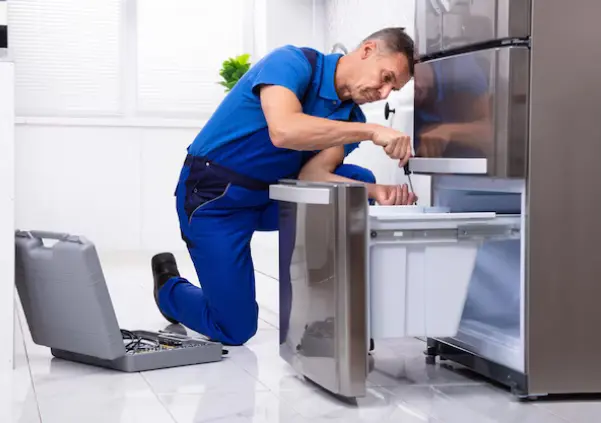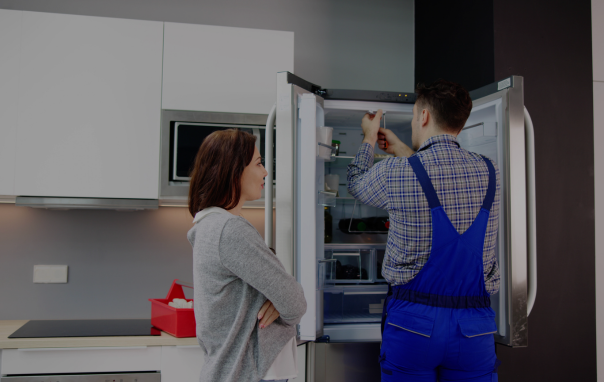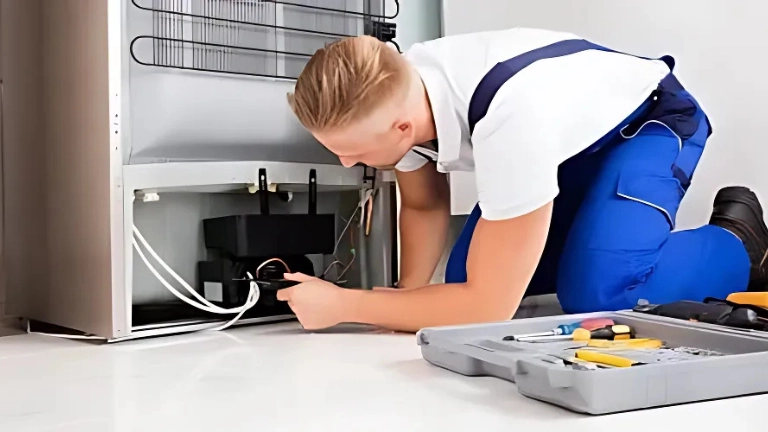Why Is My Refrigerator Not Cooling? Troubleshooting Guide

A refrigerator that isn’t cooling properly can be incredibly frustrating, especially when it results in spoiled food. The problem could stem from a variety of issues, ranging from simple maintenance needs to more complex mechanical failures. In this troubleshooting guide, we’ll walk you through the most common reasons why your refrigerator isn’t cooling and provide solutions to fix them. Whether it’s the compressor, dirty condenser coils, or faulty evaporator fans, understanding the cause will help you take the right steps toward restoring your fridge’s functionality.
Overview of refrigerator not cooling
If your refrigerator is not cooling properly, a faulty thermistor or temperature sensor could be the issue. These components help regulate the internal temperature of your fridge, and if they malfunction, it can lead to inconsistent cooling. Diagnosing and replacing a damaged thermistor requires the expertise of a qualified service technician. While the cost of repairs can vary, addressing these issues early can help avoid more expensive repairs down the line. Always consult with a professional to ensure accurate diagnosis and efficient solutions.
Assessing Temperature Control Settings
Check the Thermostat and Temperature Control
The first step in troubleshooting a refrigerator that isn’t cooling is to check the temperature control settings. If your refrigerator’s thermostat is set too high, the appliance will not cool properly. For most refrigerators, the ideal temperature for the refrigerator compartment is between 37°F and 40°F (3°C to 4°C), while the freezer should be set at 0°F (-18°C). If your settings are correct but cooling issues persist, there could be a malfunction with the temperature control board or other components.

Checking the Condenser Coils for Dirt or Blockages
Cleaning Dirty Condenser Coils
One of the most common reasons for a refrigerator not cooling is dirty condenser coils. The condenser coils dissipate heat, allowing the refrigerator to cool effectively. If these coils are clogged with dust, dirt, or pet hair, they can’t release heat properly. Dirty coils are often the cause of cooling issues, so cleaning them is a key step. Use a vacuum or coil brush to clean the coils and ensure they are free of debris. This simple maintenance task can improve the efficiency of your refrigerator and restore cooling performance.
Inspecting the Evaporator Fan for Operational Efficiency
Ensuring Proper Airflow
The evaporator fan circulates the cold air produced by the evaporator coils to maintain a consistent temperature inside the fridge and freezer. If the fan motor is broken or obstructed, the cold air may not circulate properly. To check if the fan is working, listen for a humming sound when the refrigerator is running. If you don’t hear the fan operating, it may need to be replaced. Additionally, check for ice buildup around the evaporator coils, which could cause the fan to freeze and malfunction.
Diagnosing Potential Issues with the Compressor
Understanding Compressor Problems
The compressor is the heart of the refrigerator’s cooling system. It compresses the refrigerant and circulates it through the coils to absorb heat. If your refrigerator isn’t cooling, a faulty compressor could be the culprit. Signs of a malfunctioning compressor include strange noises or the refrigerator not cooling at all. If you suspect an issue with the compressor, it’s best to contact a professional technician for an accurate diagnosis and repair. Compressor issues are often complex and require specialized knowledge to fix.
Examining the Circuit Board for Malfunctions
Check for Electronic Control Failures
The circuit board controls many of your refrigerator’s electrical functions, including temperature regulation, fan operation, and defrost cycles. If the control board malfunctions, the refrigerator may not cool properly. Signs of circuit board failure include irregular cooling cycles or no cooling at all. You may notice issues with the temperature control panel or error codes displayed on the screen. If the circuit board is damaged, it may need to be replaced by a licensed technician.
Ensuring Proper Airflow Around the Refrigerator
Space and Ventilation Requirements
Proper airflow is crucial for the refrigerator’s cooling system to function effectively. If the fridge is too close to the wall or blocked by other appliances, airflow can be restricted, leading to cooling issues. Ensure there is at least 2 inches of space around the refrigerator for proper ventilation. Additionally, avoid overcrowding the interior, as this can block air vents and disrupt airflow. Keeping the evaporator fan motor and condenser fan motor functioning properly is essential for consistent cooling performance.
Checking Door Seals for Integrity
Inspecting the Gaskets
A damaged door seal can cause cool air to escape and warm air to enter the refrigerator, making it harder for the appliance to maintain a cold temperature. Inspect the rubber door seals for cracks, tears, or wear. Clean the seals regularly with warm soapy water to remove food particles or grime that may be affecting their performance. If the seals are damaged or worn, replacing them is necessary for maintaining energy efficiency and preventing temperature fluctuations.
Examining the Defrost Drain for Obstructions
Clearing Blocked Defrost Drain
A blocked defrost drain is a common cause of water pooling inside the refrigerator. If the drain becomes clogged with food particles or ice, water cannot flow properly, leading to excess moisture and poor cooling. Use warm water or a pipe cleaner to remove any blockages. Cleaning the drain regularly can prevent mold growth and improve the refrigerator’s cooling efficiency.
Verifying the Location of the Refrigerator
Proper Placement for Efficient Cooling
The location of your refrigerator can impact its cooling efficiency. If your fridge is placed near a heat source like an oven or direct sunlight, it will struggle to cool effectively. Make sure the fridge is in a cool, dry area with enough space around it for ventilation. Avoid placing your refrigerator near heat-generating appliances or areas that experience temperature fluctuations.
Ensuring the Drain Pan is Clean and Positioned Correctly
Cleaning and Adjusting the Drain Pan
The drain pan collects excess water during the defrost cycle. If the pan is dirty or misaligned, it could lead to water buildup and cooling problems. Check the drain pan regularly and clean it as needed. Ensure that it is properly positioned to catch any excess water. Keeping the drain pan clean will help maintain proper temperature regulation and prevent water damage inside the refrigerator.
Identifying Frost Build-Up in the Freezer
Addressing Frost Build-Up
Excess frost buildup in the freezer compartment can block airflow and cause temperature issues. If the defrost cycle isn’t working properly, frost can accumulate on the evaporator coils, making the refrigerator less efficient. To resolve this, manually defrost the freezer and remove any ice buildup. If the issue persists, it may be necessary to repair or replace the defrost heater or defrost timer.
Monitoring for Unusual Noises from the Appliance
Diagnosing Strange Noises
Unusual noises from your refrigerator, such as clicking, buzzing, or humming, can indicate a problem with the compressor, fan motors, or defrost system. For example, a gurgling sound may indicate a refrigerant issue, while a humming noise could suggest a problem with the condenser fan. If you notice any strange sounds, it’s important to diagnose the cause promptly to prevent further damage.
Looking for Power Issues or Circuit Breaker Trips
Checking for Electrical Issues
If your refrigerator is not cooling, the power supply could be the issue. Check the power cord and plug for damage, and ensure the refrigerator is properly plugged into an electrical outlet. Additionally, inspect the circuit breaker to ensure that power to the appliance hasn’t been interrupted. If the refrigerator is not receiving power, it may be necessary to have a licensed technician examine the electrical components.
Inspecting the Temperature Setting in the Freezer
Freezer Temperature Settings
If your refrigerator is cooling fine, but the freezer isn’t, it may be due to incorrect temperature settings. Ensure that the freezer is set to the correct temperature, ideally 0°F (-18°C). If the freezer is set too high, it may not stay cold enough to keep food frozen. Adjust the temperature setting, and if the problem persists, there may be an issue with the freezer compartment’s evaporator fan or defrost system.
Common Signs of a Failing Compressor
Recognizing a Bad Compressor
A failing compressor is one of the most serious issues that can cause your refrigerator to stop cooling. If the compressor is malfunctioning, you may notice warm temperatures inside the fridge, even though the appliance is running. If the compressor motor is running but the fridge isn’t cooling, it could indicate a refrigerant leak or a faulty compressor relay. In these cases, it’s important to contact a professional appliance repair service for an expert diagnosis and repair.
When to Call a Certified Technician
Professional Help for Complex Issues
While many refrigerator issues can be fixed with basic troubleshooting, more complex problems like compressor failure, refrigerant leaks, or electrical malfunctions require professional attention. If your fridge is still not cooling after you’ve checked the thermostat, cleaned the condenser coils, and addressed the evaporator fan, it’s time to call a licensed appliance repair technician. Professional technicians have the experience and expertise to handle complex repairs and restore your refrigerator to optimal performance.

Why Choose Toronto Refrigeration?
At Toronto Refrigeration, we are committed to providing efficient and reliable refrigerator repairs. Our team of experienced technicians specializes in diagnosing and fixing all types of refrigerator problems, from cooling issues to compressor malfunctions. Whether you need routine maintenance or urgent repairs, we offer same-day service and transparent pricing. With our expert advice and commitment to excellent customer service, we ensure that your refrigerator is back to working order in no time.
Conclusion
A refrigerator that isn’t cooling properly can be a major inconvenience, but many common issues can be resolved with basic troubleshooting. By checking the temperature controls, cleaning the condenser coils, inspecting the evaporator fan, and addressing other potential issues, you can often fix the problem yourself. However, more serious issues like compressor failure or refrigerant leaks require professional help. If your refrigerator is still not cooling after troubleshooting, don’t hesitate to contact Toronto Refrigeration for expert repairs. We’ll help restore your fridge to optimal performance so you can keep your food fresh and your kitchen running smoothly.